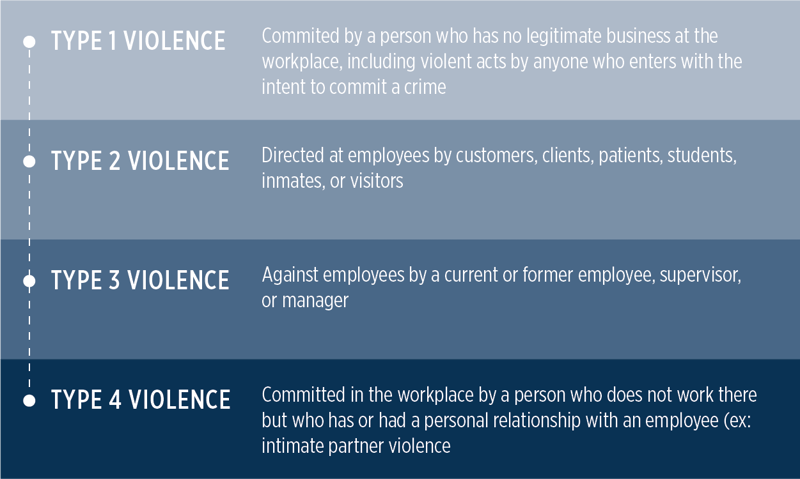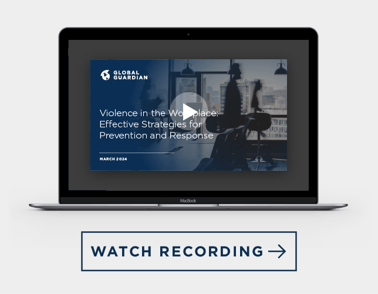Organizations must do more to protect their personnel from the threats or actions of violence. Here are seven steps they can take to help mitigate and respond to workplace violence.

|
April 10, 2024 INSIDE THIS ARTICLE, YOU'LL FIND: |
Workplace violence is more than just the occasional headline. It’s a pervasive issue for many workers, and causes serious harm, both physical and emotional, and in some tragic cases, even death.
From hospitals and construction sites to retail stores and offices, workplace violence can come in many forms and happen anywhere. As many as 761,000 workers experience some form of physical assault in the workplace each year (according to the NSC), and the current or former workplaces of perpetrators were the most common sites for mass shootings. Even less harrowing events like threats or intimidation can be damaging to a workplace’s morale, culture, and output.
There are often opportunities to prevent or lessen workplace violence through proactive measures to ensure a safe and secure work environment. Having clear plans and procedures around workplace violence is not just good policy, it’s part of an employer’s duty of care obligations.
In a recent Global Guardian webinar, experts discussed how organizations can tackle this difficult issue. Here are seven steps that any workplace can take to help reduce the threat of violence.
1. Understand the problem
To ensure that everyone in your organization is bought into the idea of reducing workplace violence, it’s important to understand the scope of the problem — how many people it affects, the impact of violence on both personnel and the overall organization, and what forms it takes.
Consider the following numbers:
- There were 1.3 million non-fatal violent crimes in the workplace annually from 2015-2019.
- 61% of employees who self-reported violence said that they had experienced it three or more times in their working lives — suggesting that the problem is pervasive and on-going.
- Sadly, 50% of employees are too afraid to report workplace violence, which means the actual number of incidents is likely far higher.
- The National Security Council estimates that more than $171 billion is lost directly and indirectly due to workplace violence.
The term “workplace violence” is broad and can refer to a large number of actions by various people, whether they are current or former employees or those who are related to employees. There is a strong link between domestic violence and workplace violence, and in both areas, organizations must do more to protect their personnel from these threats.
In general, workplace violence is broken down into four categories:

You can also describe workplace violence by the type of act, such as assault, or written messages that convey intent to harm. In most cases, the most terrifying type of workplace is unfortunately one that is all too common: a workplace shooting.
Between 1966 and 2021, there were 53 workplace shootings carried out across the United States. This number represented more than 30% of the 188 mass shootings (excluding schools) recorded during that period, according to the Violence Project.
No matter how you slice the data, the issue is clear: The threat of a mass shooting, or other violent act, is a real danger to your workplace, no matter where you operate. Taking the issue seriously is a must at this point.
WATCH: Global Guardian recently hosted a webinar on workplace violence, covering prevention and response strategies, featuring Robin Welch Stearns (President and Founder of Pacific Resilience Group) and Raymond Carreira (VP of Security at a16z).
2. Create a written workplace violence prevention plan
A written plan that covers every aspect of preventing and addressing workplace violence is essential, and may soon be required for businesses of many sizes across the country.
When putting together a written workplace violence prevention plan, you should consider including the following:
- Name the people responsible for implementing the plan.
- Lay out the system for identifying and evaluating workplace hazards, including scheduled periodic inspections to identify unsafe conditions and work practices.
- Identify the methods and procedures for correcting unsafe or unhealthy conditions and work practices promptly.
- Creating an occupational health and safety training program designed to instruct employees in general safe and healthy work practices.
- Build a system for communicating with employees on occupational health and safety matters, including provisions designed to encourage employees to report hazards at the worksite without fear of reprisal.
- Build a system for ensuring that employees comply with safe and healthy work practices, which may include disciplinary action.
The above recommendations are inspired by California’s new law, SB 553, which mandates that most California employers adopt comprehensive workplace violence prevention plans that include this information.
The law also requires employers to keep records of workplace violence hazards and investigations, maintain a violent incident log, and provide annual training. Many expect other states to follow California’s lead with SB 553, so consider familiarizing yourself with the bill and its requirements even if you live outside of the state.
3. Lean on technology for prevention and reaction
There are many technological controls and solutions for workplace violence, which run the gamut from preventing violence, to mitigating its impact, to reacting to an event. Investing in the controls that are right for your business can pay massive dividends.
Consider this list from the National Security Council, which shows a spectrum of technologies that can help your organization.

4. Provide employee training
Training that maps to your workplace violence prevention plan will help employees, regardless of role or risk level, adhere to best practices. Programs can focus on everything from anti-bullying strategies, to identifying the warning signs of an impending act of violence, to managing a stressful situation before it turns into something more dire.
Employees should have access to your written prevention plan and understand their role in preventing, mitigating, and reacting to any violence on a worksite.
5. Encourage a culture of reporting
As mentioned above, not every employee feels safe or comfortable reporting an act of workplace violence. They may fear retaliation from management, or future intimidation or violence from other employees.
Unfortunately, a workplace violence prevention campaign is useless without the capacity for employees to share what is happening. It’s incumbent upon the organization to create multiple, safe, confidential channels — such a phone hotline, or online reporting system – through which they can report workplace violence incidents and updates. The reporting procedures should be made clear in the organization's prevention plan.
6. Conduct risk assessments
Preventing workplace violence is part of a larger mission for any organization, which is safeguarding the security of its personnel. This is the organization’s duty of care, or their responsibility to promote the health, safety, and wellbeing of their employees wherever they are in the world.
Part of an employer’s duty of care responsibilities is to conduct regular risk assessments, where they identify potential hazards and what would happen if a crisis occurred.
Many companies enlist a duty of care provider or other risk management solution to help conduct these assessments and make sure they are not just legally compliant but operationally ready to tackle any issue that arises. Workplace violence is just one part of the larger puzzle of risk that many organizations assume today, which is why getting third-party assistance is so helpful.
7. Commit to continuous improvement
Even if you write the perfect workplace violence prevention plan, provide robust training that receives stellar feedback, and work with the world’s best duty of care providers, your work preventing and mitigating workplace violence is never done. Commit to continuous improvement: conduct post-event analyses to identify how policies and methods may have fallen short; review your materials consistently and update them with the best and most recent information; communicate with your team to see how you could improve reporting functions or training modules. Most of all, stay aware of the threat of violence in your workplace, and how risks might change with new technology, changing laws, and shifting tensions within your workforce and the world at large.
 On-Demand workplace Violence Webinar
On-Demand workplace Violence Webinar
In our webinar on how to prevent workplace violence, Global Guardian convened a panel of experts to answer questions that business owners, leaders, and HR professionals had on the topic, particularly as it relates to California’s SB 553. The webinar has a wealth of information on recent trends in workplace violence, strategies for fostering safer environments, and how to get the support you need for planning, implementation, and execution.
Alongside the webinar, Global Guardian also published additional questions and answers about workplace violence and SB 553 from Robin Welch Stearns, Founder and President of Pacific Resilience Group. If your question isn't addressed, contact Global Guardian for further guidance.
StandinG By to Support
The Global Guardian team is standing by to support your duty of care and security requirements with a comprehensive suite of solutions. To learn more about our duty of care services, complete the form below or call us at + 1 (703) 566-9463.



